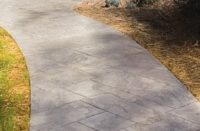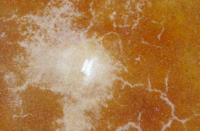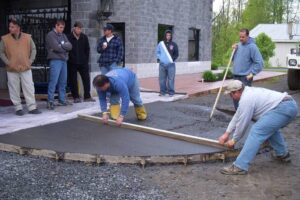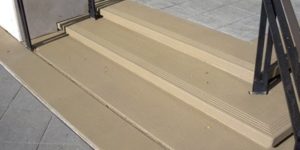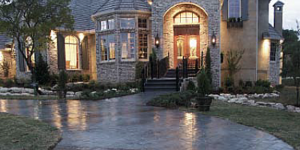
Placing and finishing concrete to maximize the visual appeal of integral coloring starts at the bottom — with a well-draining, compacted aggregate and consistent subgrade. It’s well worth the time and effort to get it right and give decorative concrete a great start to standing up to the elements.
Concrete won’t cure evenly if it’s poured over an inconsistent subgrade or a mix of materials that might include dirt, plastic, wood, asphalt and existing concrete.
In cold weather, cover the prepared site with plastic or concrete blankets unless placing concrete that day. Remove covers just before placing to keep the subgrade dry and retain the ground heat. This will increase finishing time and add to the consistency of the finish and color.
In hot conditions, dampen the subgrade before pouring. This will keep the moisture from being drawn from the concrete too fast. Wet the aggregate up to the time of placing the concrete without allowing the water to pool.
If the plans call for multiple pours in one day, and the weather conditions are expected to be hot and dry, wetting the subgrade is important. This detail needs to be addressed before the first pour of the day.
If the plans call for wetting the subgrade at the 1 p.m. pour, you’ll need to wet the subgrade on the first pour of the day. This may add slightly to the set time in the morning hours but could help produce a more consistent final product.
Broom finish
Of all the decorative concrete finishes, a broom finish is one of the most common and the most difficult to master. A consistent 4-inch slump is recommended for concrete flatwork with integral color.
Schedule placement of integrally colored concrete when weather is favorable. Place as many pours as manageable in the shortest amount of time so that each individual pour dries in the same weather condition as the concrete placed around it.
When the concrete surface is ready to broom finish, dampen the broom one time only and shake out excess water. This will avoid adding water to the surface which causes white streaking. After each pass, run your hand or a wooden stake across the hairs to remove any buildup. Don’t wash the broom or dip it in water between passes during the brooming process.
A good concrete broom is money well spent. There are several on the market that have nylon resin bristles, retain their shape and have little build-up problems.
Admixtures and mix designs
Integrally colored concrete is receptive to a wide range of admixtures except for calcium chloride, which will leave the concrete surface with uneven coloring. Nonchloride accelerators work well with colored concrete and are readily available across the country. Hot water is a great alternative to a chemical accelerator.
Other admixtures that are gaining popularity are fly ash and ground blast furnace slag. Both can be used as a cement replacement or added to a mix design to increase workability and strength. It’s important that you treat these admixtures as cementitious material when calculating your color dosage. Additional color may be needed.
Air entrainment, the intentional creation of tiny air bubbles in concrete, will not affect color and is still required where freeze-thaw conditions exist and where deicing agents are used. When pouring indoors or over a vapor barrier, a small addition of air entrainment can reduce bleed water. Ask your local ready-mix supplier about these products.
It’s important that mix designs stay consistent throughout the job. For best results, keep concrete as close to a 4-inch slump as possible. If a more flowable concrete mix design is needed, water reducers or plasticizers are recommended to keep the water-to-cement ratio correct.
I encourage you to have preliminary meetings with ready-mix technicians to help design a concrete mix that will best fulfill your needs. This is important with all facets of decorative concrete.
A stamp mix design may be needed for a job using a smaller aggregate or less aggregate/more sand or a delay set. Your next project may be a low loading of color with an ornamental aggregate for exposing. Ask your ready-mix technician about the characteristics of the aggregate. Harder aggregates don’t absorb much, if any, water. They tend to generate a lot of bleed water where softer rock tends to absorb water and may need to be dampened before loading into a truck.
